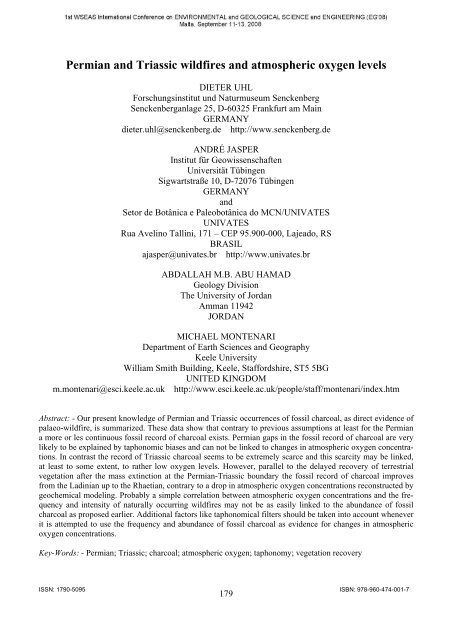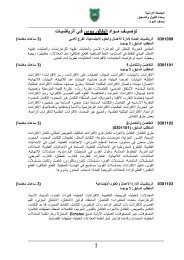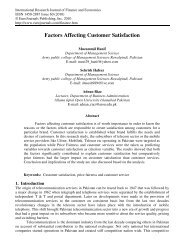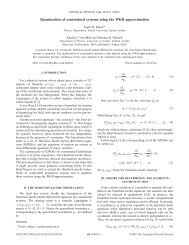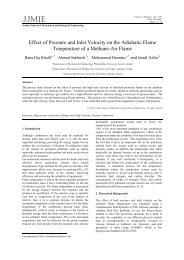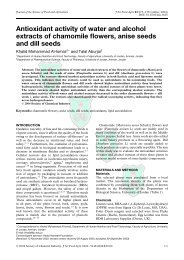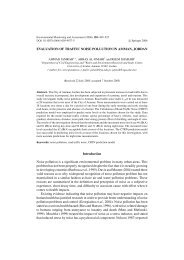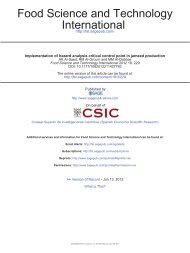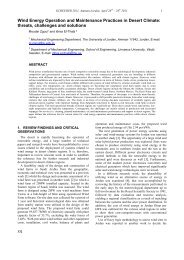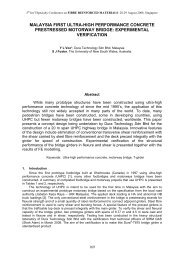10.Permian and Triassic wildfires .pdf - The University of Jordan
10.Permian and Triassic wildfires .pdf - The University of Jordan
10.Permian and Triassic wildfires .pdf - The University of Jordan
Create successful ePaper yourself
Turn your PDF publications into a flip-book with our unique Google optimized e-Paper software.
Permian <strong>and</strong> <strong>Triassic</strong> <strong>wildfires</strong> <strong>and</strong> atmospheric oxygen levels<br />
DIETER UHL<br />
Forschungsinstitut und Naturmuseum Senckenberg<br />
Senckenberganlage 25, D-60325 Frankfurt am Main<br />
GERMANY<br />
dieter.uhl@senckenberg.de http://www.senckenberg.de<br />
ANDRÉ JASPER<br />
Institut für Geowissenschaften<br />
Universität Tübingen<br />
Sigwartstraße 10, D-72076 Tübingen<br />
GERMANY<br />
<strong>and</strong><br />
Setor de Botânica e Paleobotânica do MCN/UNIVATES<br />
UNIVATES<br />
Rua Avelino Tallini, 171 – CEP 95.900-000, Lajeado, RS<br />
BRASIL<br />
ajasper@univates.br http://www.univates.br<br />
ABDALLAH M.B. ABU HAMAD<br />
Geology Division<br />
<strong>The</strong> <strong>University</strong> <strong>of</strong> <strong>Jordan</strong><br />
Amman 11942<br />
JORDAN<br />
MICHAEL MONTENARI<br />
Department <strong>of</strong> Earth Sciences <strong>and</strong> Geography<br />
Keele <strong>University</strong><br />
William Smith Building, Keele, Staffordshire, ST5 5BG<br />
UNITED KINGDOM<br />
m.montenari@esci.keele.ac.uk http://www.esci.keele.ac.uk/people/staff/montenari/index.htm<br />
Abstract: - Our present knowledge <strong>of</strong> Permian <strong>and</strong> <strong>Triassic</strong> occurrences <strong>of</strong> fossil charcoal, as direct evidence <strong>of</strong><br />
palaeo-wildfire, is summarized. <strong>The</strong>se data show that contrary to previous assumptions at least for the Permian<br />
a more or les continuous fossil record <strong>of</strong> charcoal exists. Permian gaps in the fossil record <strong>of</strong> charcoal are very<br />
likely to be explained by taphonomic biases <strong>and</strong> can not be linked to changes in atmospheric oxygen concentrations.<br />
In contrast the record <strong>of</strong> <strong>Triassic</strong> charcoal seems to be extremely scarce <strong>and</strong> this scarcity may be linked,<br />
at least to some extent, to rather low oxygen levels. However, parallel to the delayed recovery <strong>of</strong> terrestrial<br />
vegetation after the mass extinction at the Permian-<strong>Triassic</strong> boundary the fossil record <strong>of</strong> charcoal improves<br />
from the Ladinian up to the Rhaetian, contrary to a drop in atmospheric oxygen concentrations reconstructed by<br />
geochemical modeling. Probably a simple correlation between atmospheric oxygen concentrations <strong>and</strong> the frequency<br />
<strong>and</strong> intensity <strong>of</strong> naturally occurring <strong>wildfires</strong> may not be as easily linked to the abundance <strong>of</strong> fossil<br />
charcoal as proposed earlier. Additional factors like taphonomical filters should be taken into account whenever<br />
it is attempted to use the frequency <strong>and</strong> abundance <strong>of</strong> fossil charcoal as evidence for changes in atmospheric<br />
oxygen concentrations.<br />
Key-Words: - Permian; <strong>Triassic</strong>; charcoal; atmospheric oxygen; taphonomy; vegetation recovery<br />
ISSN: 1790-5095 ISBN: 978-960-474-001-7<br />
179
1 Introduction<br />
It has been predicted for several regions <strong>of</strong> the<br />
world that an increased frequency <strong>of</strong> <strong>wildfires</strong> together<br />
with their negative impacts on human civilization,<br />
will come along with a future climate change<br />
[29]. Such a climate change from icehouse conditions<br />
to a greenhouse world occurred also during the<br />
Permian <strong>and</strong> the <strong>Triassic</strong> [7, 23, 25]. Knowledge<br />
regarding the development <strong>of</strong> fire-frequencies as<br />
well as the intensities <strong>of</strong> fire induced devastation<br />
during this period is therefore essential for any<br />
evaluation <strong>of</strong> potential effects <strong>of</strong> a future or contemporary<br />
climate change - not only from an ecological,<br />
but also from an economical <strong>and</strong> political point <strong>of</strong><br />
view.<br />
<strong>The</strong> occurrence <strong>of</strong> fossil charcoal in sediments is<br />
widely accepted as the direct evidence <strong>of</strong> palaeo<strong>wildfires</strong><br />
[32, 33, 34]. So far, the oldest undisputed<br />
charcoal has been described from the Late Silurian<br />
<strong>of</strong> West-Engl<strong>and</strong> [13], <strong>and</strong> from this time on there is<br />
a more or less continuous fossil record <strong>of</strong> charcoal<br />
[28, 33]. During the last decades special attention<br />
has been paid to the Late Carboniferous. For this<br />
time very high atmospheric O2-concentrations have<br />
been reconstructed using geochemical modeling<br />
methods [1, 4]. Furthermore, widespread evidence<br />
exists for very intense fires within various terrestrial<br />
ecosystems [9, 10, 33].<br />
Several authors have speculated that fire frequencies,<br />
as represented by the abundance <strong>and</strong> frequency<br />
<strong>of</strong> fossil charcoal, have decreased during the<br />
Latest Carboniferous <strong>and</strong> Permian, because <strong>of</strong> a<br />
drop in atmospheric O2-concentrations [26, 27, 33].<br />
This assumption is based on experimental data,<br />
which indicate a required atmospheric oxygen concentration<br />
<strong>of</strong> at least 13% for sustained biomass<br />
combustion [5, 6]. According to the reconstruction<br />
by Berner <strong>and</strong> Canfield [4] the atmospheric oxygen<br />
concentration would have dropped below this level<br />
during the Late Permian. More recent results from<br />
geochemical modeling, however, moved the high<br />
O2-peak forward into the Permian <strong>and</strong> the acclaimed<br />
threshold <strong>of</strong> 13% atmospheric oxygen has probably<br />
not been reached before the <strong>Triassic</strong> (cf. Fig. 1; [2,<br />
3]). Following this new reconstruction it has to be<br />
questioned whether changes in the atmospheric<br />
oxygen concentration are indeed the main reasons<br />
for the observed decrease <strong>of</strong> evidence for <strong>wildfires</strong><br />
during the Latest Carboniferous <strong>and</strong> the Permian, as<br />
well as the <strong>Triassic</strong> or whether additional reasons<br />
have to be taken into account for the low charcoal<br />
abundances <strong>and</strong> frequencies during this period.<br />
Here we present a tentative overview <strong>of</strong> previously<br />
published, as well as hitherto unpublished records<br />
<strong>of</strong> Permian <strong>and</strong> <strong>Triassic</strong> charcoals during this<br />
periods, to establish a first temporal framework for<br />
the causal interpretation <strong>of</strong> the fossil record <strong>of</strong> <strong>wildfires</strong><br />
during this time.<br />
2 Records <strong>of</strong> Permian charcoal<br />
Most detailed reports on Late Palaeozoic charcoal<br />
from the northern hemisphere prior to the extensive<br />
review on Pre-Quaternary fires by Scott [33] came<br />
from Westphalian <strong>and</strong> pre-Westphalian deposits.<br />
For the Stephanian <strong>and</strong> the entire Permian, only few<br />
investigations had been made on this subject up to<br />
this date [30, 31, 35]. Although the occurrence <strong>of</strong><br />
charcoal has anecdotally been reported from a number<br />
<strong>of</strong> localities from the latest Carboniferous<br />
(‘‘post’’-Stephanian C = lowermost Rotliegend <strong>of</strong><br />
Central Europe) <strong>and</strong> Permian <strong>of</strong> Central Europe (cf.<br />
[39] <strong>and</strong> citations therein), no detailed descriptions<br />
<strong>of</strong> the material had been given <strong>and</strong> no anatomical or<br />
petrologic evidence supporting such an interpretation<br />
<strong>of</strong> the respective material had been presented.<br />
Only recently it has been demonstrated that in<br />
the rather humid Lower Rotliegend (upper Gzhelian<br />
– Asselian) <strong>of</strong> the Saar-Nahe basin in SW Germany<br />
all sedimentary lithologies investigated so far<br />
yielded charcoal remains in varying abundance (cf.<br />
Fig. 2A) [39]. In contrast most sedimentary facies<br />
(i.e. red beds, deposited under strong climatic seasonality)<br />
from the more arid Upper Rotliegend (Asselian<br />
– Sakmarian) <strong>of</strong> this area yielded no macroscopically<br />
identifiable charcoal remains (cf. Fig. 2B)<br />
[39]. Only in volcanically influenced sediments<br />
charcoal has been found here. However, in these<br />
cases most charcoals were silicified <strong>and</strong> the few<br />
non-silicified charcoals were found in tuffs or tuffites<br />
that have been deposited subaquatically [39].<br />
As demonstrated by Skjemstad et al. [36] charcoal<br />
breaks down rapidly under semi-arid conditions <strong>and</strong><br />
it has been assumed by Uhl et al. [39] that this, together<br />
with a generally sparse vegetation cover, is<br />
also very likely the main reason for the low abundance<br />
<strong>of</strong> charcoal in sediments from the Upper Rotliegend<br />
<strong>of</strong> the Saar-Nahe basin. Additional reports<br />
<strong>of</strong> Early Permian charcoals come from Northern<br />
America, where fossil charcoal has been discovered<br />
at several localities in lacustrine <strong>and</strong> marine sediments<br />
[30, 31, 33]. Charcoal found in coals [17, 19,<br />
37] <strong>and</strong> in lacustrine Kungurian s<strong>and</strong>stones <strong>of</strong> the<br />
ISSN: 1790-5095 ISBN: 978-960-474-001-7<br />
180
Rio Bonito Formation, in the Paraná Basin, South<br />
Brazil (Fig. 2C), is pro<strong>of</strong> that during the Early Permian<br />
<strong>wildfires</strong> also occurred in the mid latitudes <strong>of</strong><br />
Gondwana.<br />
<strong>The</strong> up to now the published record <strong>of</strong> Middle<br />
Permian charcoal is rather scarce. So far only a few<br />
reports <strong>of</strong> fossil charcoal from this period have been<br />
substantiated by anatomical [8] or petrographic evidence<br />
[12]. However, records <strong>of</strong> Middle Permian<br />
<strong>wildfires</strong> are geographically widespread, including<br />
the Euramerican floral province [8], Cathaysia [42]<br />
<strong>and</strong> the high latitudes <strong>of</strong> Southern Gondwana [12].<br />
Plant bearing localities from the Late Permian <strong>of</strong><br />
the Northern hemisphere, especially from<br />
Euramerica, are very rare. An analysis <strong>of</strong> marine<br />
marls from the lower Zechstein (Wuchiapingian) <strong>of</strong><br />
NW-Hesse (Germany) provided abundant charcoal<br />
fragments, not only consisting <strong>of</strong> charred woods, but<br />
also <strong>of</strong> charred conifer needles (cf. Fig. 2D–E) [38].<br />
Remains <strong>of</strong> Wuchiapingian charcoal have also been<br />
discovered in Zechstein sediments near the ab<strong>and</strong>oned<br />
village <strong>of</strong> Culmitzsch in E-Thuringia (Germany)<br />
(cf. Fig. 2F). Further reports <strong>of</strong> Wuchiapingian<br />
charcoals come from Cathaysia, were a lycopsid<br />
dominated vegetation experienced more or less<br />
regular <strong>wildfires</strong> during this time [41, 42, 43].<br />
Additional to charcoals from the Late Permian <strong>of</strong><br />
Central Europe <strong>and</strong> China also charcoals from the<br />
uppermost Permian (Changhsingian) deposits <strong>of</strong><br />
<strong>Jordan</strong> have recently been discovered (Fig. 2G),<br />
which testify for the first time to the occurrence <strong>of</strong><br />
palaeo-<strong>wildfires</strong> in the low latitudes <strong>of</strong> Northern<br />
Gondwana during this period [40]. <strong>The</strong>se charcoals<br />
are abundant in facies types, like clays deposited in<br />
ab<strong>and</strong>oned channels, which are favourable for the<br />
preservation <strong>of</strong> charcoal, whereas other facies types<br />
deposited under more dry conditions yielded no<br />
macroscopically identifiable charcoal at all.<br />
3 Records <strong>of</strong> <strong>Triassic</strong> charcoal<br />
Charcoal is extremely rare in clastic sediments from<br />
the <strong>Triassic</strong> [33] <strong>and</strong> only a few reports deal with<br />
<strong>Triassic</strong> charcoal in detail. Substantiated reports on<br />
macroscopically identifiable charcoal from the Early<br />
<strong>Triassic</strong> (Indusian – Olenekian) <strong>and</strong> the Anisian are<br />
completely missing so far. Only occasionally shattered<br />
remains <strong>of</strong> charcoal have been reported from<br />
studies on the palyn<strong>of</strong>acies <strong>of</strong> early to middle <strong>Triassic</strong><br />
sediments [24]. So far the oldest substantiated<br />
<strong>Triassic</strong> record <strong>of</strong> macroscopically identifiable charcoal<br />
comes from the Ladinian <strong>of</strong> S-Germany [20,<br />
21, 22]. <strong>The</strong> record <strong>of</strong> Carnian <strong>and</strong> Norian charcoal<br />
is also extremely scarce, but the occurrence <strong>of</strong> charcoal<br />
has repeatedly been testified for N-America<br />
[18, 45], as well as S-Germany [20, 21, 22].<br />
Harris [15, 16] described charcoal from Rhaetian<br />
– Liassic fissure fills in Carboniferous limestones <strong>of</strong><br />
South Wales. Although Harris [15] could give no<br />
definitive age assignments for his material he stated<br />
that it would be most likely <strong>of</strong> lower Liassic age,<br />
based on taxonomic similarities with Liassic floras<br />
from S-Germany. Harris [16] also reported the occurrence<br />
<strong>of</strong> charcoal in Rhaetian – Lower Liassic<br />
deltaic deposits <strong>of</strong> Eastern Greenl<strong>and</strong>. In this case<br />
the charcoal has not been identified, but it is abundant<br />
<strong>and</strong> has a widespread occurrence in this area.<br />
Later on Scott [33] considered the charcoal described<br />
by Harris [15, 16] to be <strong>of</strong> Early Jurassic<br />
age. In S-Germany (Franconia, Bavaria) charcoal<br />
has also been recorded from Rhaetian sediments<br />
[20, 21, 22]. In SW-Germany charcoal is frequent in<br />
Rhaetian s<strong>and</strong>stones (Fig. 2H–I). This material<br />
shows characteristics which are considered to be<br />
typical for charcoal by several authors [33], like<br />
black streak, silky lustre <strong>and</strong> homogenized cellwalls<br />
when investigated under the SEM, giving<br />
pro<strong>of</strong> to the occurrence <strong>of</strong> <strong>wildfires</strong> during the uppermost<br />
<strong>Triassic</strong> in Central Europe.<br />
4 Discussion<br />
Our brief overview has shown that the fossil record<br />
<strong>of</strong> Permian charcoals is obviously not as scarce as<br />
previously believed by various authors [18, 33], although<br />
the fossil record <strong>of</strong> Permian charcoal is in<br />
fact less abundant than that <strong>of</strong> Carboniferous charcoal<br />
[33]. However, according to recent model results<br />
the highest atmospheric oxygen concentrations<br />
were not reached during the Carboniferous, thus<br />
promoting widespread <strong>and</strong> intense <strong>wildfires</strong>, but<br />
during the Permian <strong>and</strong> probably did not fall below<br />
the assumed crucial threshold <strong>of</strong> 13% during the<br />
entire Permian (cf. Fig. 1), but remained above this<br />
level until the Lower <strong>Triassic</strong> [2]. Instead <strong>of</strong> low<br />
oxygen levels it is therefore necessary to evaluate<br />
other potential reasons for the lower abundance <strong>of</strong><br />
charcoal during the Permian.<br />
One <strong>of</strong> the potential reasons is a generally<br />
scarcer vegetation cover during the Permian in<br />
many areas worldwide, than during the Carboniferous.<br />
Climatic deterioration as well as tectonic reorganization<br />
<strong>of</strong> l<strong>and</strong>scapes led to the disappearance <strong>of</strong><br />
coal forming forests in most regions worldwide [23]<br />
ISSN: 1790-5095 ISBN: 978-960-474-001-7<br />
181
<strong>and</strong> probably the potential amount <strong>of</strong> available fuel<br />
for <strong>wildfires</strong> decreased on a large scale. Regionally<br />
such a reason has also been discussed for the<br />
scarceness <strong>of</strong> charcoal in Upper Rotliegend (Asselian<br />
– Sakmarian) sediments from SW-Germany<br />
[39]. Another potential reason are taphonomic filters<br />
<strong>and</strong> it has already been proposed that charcoal produced<br />
during <strong>wildfires</strong> has not been preserved due<br />
to degradation under the semi-arid <strong>and</strong> arid conditions<br />
prevailing during parts <strong>of</strong> the Permian [39],<br />
like it has been observed in present-day Australia<br />
where buried charcoal breaks down rapidly under<br />
semi-arid conditions [36]. Both reasons, maybe together<br />
with other, so far unidentified reasons, can<br />
probably explain the lower abundance <strong>of</strong> Permian<br />
charcoal as compared to the Carboniferous.<br />
In contrast to the Permian the record <strong>of</strong> <strong>Triassic</strong><br />
charcoal actually seems to be extremely scarce <strong>and</strong><br />
this scarcity <strong>of</strong> charcoal may in fact be linked, at<br />
least to some extent, to rather low oxygen levels,<br />
which probably dropped below 13% during parts <strong>of</strong><br />
the <strong>Triassic</strong> [2, 3]. However, these geochemical<br />
model results also suggest that oxygen levels were<br />
lowest during the <strong>Triassic</strong> – Jurassic transition interval.<br />
This low-oxygen phase corresponds at least<br />
partly to the Rhaetian, a phase with widespread <strong>and</strong><br />
abundant evidence <strong>of</strong> palaeo-<strong>wildfires</strong>. After a<br />
global “charcoal gap” from the Indusian up to the<br />
Anisian, the fossil record <strong>of</strong> charcoal seems to increase<br />
slowly from the Ladinian up to the Rhaetian,<br />
contrary to a modeled drop in atmospheric oxygen<br />
concentrations. This seems to contradict a direct<br />
relationship between oxygen concentrations <strong>and</strong><br />
fire-frequencies. However, based on physicochemical<br />
considerations <strong>and</strong> experimental evidence<br />
it has to be assumed that oxygen concentrations [5,<br />
6], together with chemical <strong>and</strong> physical properties <strong>of</strong><br />
the fuel [44], have actually an influence on the intensity<br />
<strong>and</strong> frequency <strong>of</strong> naturally occurring fires.<br />
But, why is the fossil record <strong>of</strong> charcoal increasing<br />
from the Ladinian onwards, despite low oxygen levels?<br />
A potential explanation may be linked to the<br />
recovery patterns <strong>of</strong> terrestrial vegetation seen after<br />
the devastating mass-extinction at the Permian-<br />
<strong>Triassic</strong> boundary.<br />
As Grauvogel-Stamm <strong>and</strong> Ash [14] have shown,<br />
the worldwide fossil record <strong>of</strong> l<strong>and</strong> plants is extremely<br />
scarce during an Early <strong>Triassic</strong> survival<br />
phase <strong>and</strong> only from the Anisian onward do fossil<br />
plant remains become more frequent, pointing to a<br />
recovery <strong>of</strong> terrestrial ecosystems during this period.<br />
Considering the fact that most <strong>of</strong> the potential refugia<br />
for many Early <strong>Triassic</strong> plants, which may have<br />
experienced <strong>wildfires</strong> during this period, were<br />
probably far away from the areas were sediments<br />
from this period have been deposited [11, 14] it<br />
seems likely that no charcoal as direct evidence <strong>of</strong><br />
<strong>wildfires</strong> within such potential refugia, has been deposited<br />
within sediments from this period. However,<br />
the scarce records <strong>of</strong> charcoal remains in palyn<strong>of</strong>acies<br />
samples from the Early <strong>Triassic</strong> [24] demonstrate<br />
that actually <strong>wildfires</strong> occurred somewhere in<br />
the hinterl<strong>and</strong>.<br />
It seems, that we have to consider that the<br />
scarceness <strong>of</strong> charcoal during the <strong>Triassic</strong> is not<br />
only related to the low atmospheric oxygen concentrations<br />
prevailing during this period, but also reflects<br />
the rather slow recovery <strong>of</strong> the terrestrial<br />
vegetation after the mass-extinction at the Permian-<br />
<strong>Triassic</strong> boundary. Additionally, as considered<br />
above for the Permian, taphonomic filters have to be<br />
taken into account which may have further decreased<br />
the quantity <strong>of</strong> fossil charcoal within most<br />
sediments (i.e. the widespread red beds) deposited<br />
during the <strong>Triassic</strong>.<br />
Our results <strong>and</strong> interpretations indicate that a<br />
simple correlation between atmospheric oxygen<br />
concentrations <strong>and</strong> the frequency <strong>and</strong> intensity <strong>of</strong><br />
naturally occurring <strong>wildfires</strong> may not be as easily<br />
linked to the abundance <strong>of</strong> fossil charcoal as proposed<br />
by previous authors [18, 26, 27, 33]. Additional<br />
factors like the global or regional density <strong>of</strong><br />
the vegetation, as well as taphonomic filters, which<br />
are independent from oxygen concentrations, should<br />
be taken into account whenever it is attempted to<br />
use the frequency <strong>and</strong> abundance <strong>of</strong> fossil charcoal<br />
as evidence for changes in atmospheric oxygen concentrations.<br />
References:<br />
[1] Berner, R.A., Modelling atmospheric O2 over<br />
Phanerozoic time, Geochimica et Cosmochimica<br />
Acta, Vol. 65, 2001, pp. 685-694.<br />
[2] Berner, R.A., Examination <strong>of</strong> hypotheses for<br />
the Permo-<strong>Triassic</strong> boundary extinction by carbon<br />
cycle modeling, Proceedings <strong>of</strong> the National<br />
Academy <strong>of</strong> Sciences, Vol. 99, 2002, pp.<br />
4172-4177.<br />
[3] Berner, R.A., <strong>The</strong> carbon <strong>and</strong> sulfur cycles <strong>and</strong><br />
atmospheric oxygen from middle Permian to<br />
middle <strong>Triassic</strong>, Geochimica et Cosmochimica<br />
Acta, Vol. 69, 2005, pp. 3211-3217.<br />
ISSN: 1790-5095 ISBN: 978-960-474-001-7<br />
182
[4] Berner, R.A., <strong>and</strong> Canfield, D.E., A new model<br />
for atmospheric oxygen over Phanerozoic time,<br />
American Journal <strong>of</strong> Science, Vol. 289, 1989,<br />
pp. 333–361.<br />
[5] Clark, F.R.S., <strong>and</strong> Russell, D.A., Fossil charcoal<br />
<strong>and</strong> the palaeoatmosphere, Nature, Vol.<br />
290, 1981, pp. 428.<br />
[6] Cope, M.J., <strong>and</strong> Chaloner, W.G., Fossil charcoal<br />
<strong>and</strong> the palaeoatmosphere. Reply, Nature,<br />
Vol. 290, 1981, pp. 428.<br />
[7] DiMichele, W.A., Pfefferkorn, H.W., <strong>and</strong> Gastaldo,<br />
R.A., Response <strong>of</strong> Late Carboniferous<br />
<strong>and</strong> Early Permian plant communities to climate<br />
change, Annual Review <strong>of</strong> Earth <strong>and</strong><br />
Planetary Science, Vol. 29, 2001, pp. 461-487.<br />
[8] DiMichele, W.A., Hook, R.W., Nelson, W.J.,<br />
<strong>and</strong> Chaney, D.S., An unusual Middle Permian<br />
flora from the Blaine Formation (Pease River<br />
group: Leonardian-Guadalupian series) <strong>of</strong> King<br />
County, West Texas, Journal <strong>of</strong> Paleontology,<br />
Vol. 78, 2004, pp. 765-782.<br />
[9] Falcon-Lang, H.J., <strong>The</strong> impact <strong>of</strong> wildfire on an<br />
Early Carboniferous coastal environment,<br />
North Mayo, Irel<strong>and</strong>, Palaeogeography, Palaeoclimatology,<br />
Palaeoecology, Vol. 139,<br />
1998, pp. 121-138.<br />
[10] Falcon-Lang, H.J., <strong>and</strong> Scott, A.C., Upl<strong>and</strong><br />
ecology <strong>of</strong> some Late Carboniferous cordaitalean<br />
trees from Nova Scotia <strong>and</strong> Engl<strong>and</strong>, Palaeogeography,<br />
Palaeoclimatology, Palaeoecology,<br />
Vol. 156, 2000, pp. 225-242.<br />
[11] Gall, J.-C., <strong>and</strong> Grauvogel-Stamm, L., <strong>The</strong><br />
early Middle <strong>Triassic</strong> ‘Grès à Voltzia’ Formation<br />
<strong>of</strong> eastern France: a model <strong>of</strong> environmental<br />
refugium, Compte Rendu Palevol, Vol.<br />
4, 2005, pp. 569-584.<br />
[12] Glasspool, I., A major fire event recorded in the<br />
mes<strong>of</strong>ossils <strong>and</strong> petrology <strong>of</strong> the Late Permian,<br />
Lower Whybrow coal seam, Sydney Basin,<br />
Australia, Palaeogeography, Palaeoclimatology,<br />
Palaeoecology, Vol. 164, 2000, pp. 373-<br />
396.<br />
[13] Glasspool, I.J., Edwards, D., <strong>and</strong> Axe, L.,<br />
Charcoal in the Silurian as evidence for the earliest<br />
wildfire, Geology, Vol. 32, 2004, pp. 381-<br />
383.<br />
[14] Grauvogel-Stamm, L., <strong>and</strong> Ash, S.R., Recovery<br />
<strong>of</strong> the <strong>Triassic</strong> l<strong>and</strong> flora from the end-Permian<br />
life crisis, Compte Rendu Palevol, Vol. 4, 2005,<br />
pp. 525-540.<br />
[15] Harris, T.M., A Liasso-Rhaetic flora in South<br />
Wales, Proceedings <strong>of</strong> the Royal Society <strong>of</strong><br />
London, ser. B, Vol. 147, 1957, pp. 289-308.<br />
[16] Harris, T.M., Forest fire in the Mesozoic, Journal<br />
<strong>of</strong> Ecology, Vol. 46, 1958, pp. 447-453.<br />
[17] Holz, M., Vieira, P.E., <strong>and</strong> Kalkreuth, W., <strong>The</strong><br />
Early Permian coal-bearing succession <strong>of</strong> the<br />
Paraná Basin in Southernmost Brazil: depositional<br />
model <strong>and</strong> sequence stratigraphy, Revista<br />
Brasileira de Geociências, Vol. 30, 2000, pp.<br />
420-422.<br />
[18] Jones, T.P., Ash, S., <strong>and</strong> Figueiral, I., Late <strong>Triassic</strong><br />
charcoal from Petrified Forest national<br />
Park, Arizona, USA, Palaeogeography, Palaeoclimatology,<br />
Palaeoecology, Vol. 188,<br />
2002, pp. 127-139.<br />
[19] Kalkreuth, W., Holz, K.M., Machado, G., Mexias,<br />
A., Silva, M.B., Willett, J., Finkelman, R.,<br />
<strong>and</strong> Burger, H., Petrology <strong>and</strong> chemistry <strong>of</strong><br />
Permian coals from the Paraná Basin: 1. Santa<br />
Terezinha, Leão-Butiá <strong>and</strong> C<strong>and</strong>iota Coalfields,<br />
Rio Gr<strong>and</strong>e do Sul, Brazil, International Journal<br />
<strong>of</strong> Coal Geology, Vol. 68, 2006, pp. 79-<br />
116.<br />
[20] Kelber, K.-P., Der Nachweis von Paläo-<br />
Wildfeuer durch fossile Holzkohlen aus dem<br />
süddeutschen Keuper, Terra Nostra, Vol. 99/8,<br />
1999, pp. 41.<br />
[21] Kelber, K.-P., Preservation <strong>and</strong> taphonomy <strong>of</strong><br />
charcoal from the Upper <strong>Triassic</strong> <strong>of</strong> southern<br />
Germany, Abstract, 12th Plant Taphonomy<br />
Meeting, 26th <strong>of</strong> October 2001, Altlengbach,<br />
Austria, 2001.<br />
[22] Kelber K-P. Die Erhaltung und<br />
paläobiologische Bedeutung der fossilen<br />
Hölzer aus dem süddeutschen Keuper (Trias,<br />
Ladinium bis Rhätium), In: Schüssler H, Simon<br />
T. (eds.): Aus Holz wird Stein - Kieselhölzer<br />
aus dem Keuper Frankens (Offsetdruck Eppe<br />
GmbH), Bergatreute-Aulendorf, 2007, pp. 37-<br />
100.<br />
[23] Kerp, H., <strong>The</strong> modernization <strong>of</strong> l<strong>and</strong>scapes during<br />
the Late Paleozoic-Early Mesozoic, Paleontological<br />
Society Papers, Vol. 6, 2000, pp.<br />
79-113.<br />
[24] Mangerud, G., <strong>and</strong> Rømuld, A., Spathian–<br />
Anisian (<strong>Triassic</strong>) palynology at the Svalis<br />
Dome, southwestern Barents Sea, Review <strong>of</strong><br />
Palaeobotany <strong>and</strong> Palynology, Vol. 70, 1991,<br />
pp. 199-216.<br />
[25] Retallack, GJ., Permian-<strong>Triassic</strong> life crisis on<br />
l<strong>and</strong>, Science, Vol. 267, 1995, pp. 77–80<br />
[26] Robinson, J.M., Phanerozoic O2 variation, fire,<br />
<strong>and</strong> terrestrial ecology, Palaeogeography, Palaeoclimatology,<br />
Palaeoecology, Vol. 75, 1989,<br />
pp. 223-240.<br />
ISSN: 1790-5095 ISBN: 978-960-474-001-7<br />
183
[27] Robinson, J.M., Phanerozoic atmospheric reconstructions:<br />
a terrestrial perspective, Palaeogeography,<br />
Palaeoclimatology, Palaeoecology,<br />
Vol. 97, 1991, pp. 51-62.<br />
[28] Rowe, N.P., <strong>and</strong> Jones, T.P., Devonian charcoal,<br />
Palaeogeography, Palaeoclimatology,<br />
Palaeoecology, Vol. 164, 2000, pp. 347-354.<br />
[29] Ryan, K.C., Global Change <strong>and</strong> Wildl<strong>and</strong> Fire.<br />
In: Wildl<strong>and</strong> fire in ecosystems: effects <strong>of</strong> fire<br />
on flora, USDA Forest Service General Technical<br />
Report, RMRS-GTR-42 (2), 2000, pp.<br />
175-184.<br />
[30] S<strong>and</strong>er, P.M., Taphonomy <strong>of</strong> the Lower Permian<br />
Geraldine bonebed in Archer County,<br />
Texas, Palaeogeography, Palaeoclimatology,<br />
Palaeoecology, Vol. 61, 1987, pp. 221-236.<br />
[31] S<strong>and</strong>er, P.M., <strong>and</strong> Gee, C.T., Fossil charcoal:<br />
techniques <strong>and</strong> applications, Review <strong>of</strong> Palaeobotany<br />
<strong>and</strong> Palynology, Vol. 63, 1990, pp.<br />
269-279.<br />
[32] Scott, A.C., Observations on the nature <strong>and</strong><br />
origin <strong>of</strong> fusain, International Journal <strong>of</strong> Coal<br />
Geology, Vol. 12, 1989, pp. 443-475.<br />
[33] Scott, A.C., <strong>The</strong> Pre-Quaternary history <strong>of</strong> fire,<br />
Palaeogeography, Palaeoclimatology, Palaeoecology,<br />
Vol. 164, 2000, pp. 297–345.<br />
[34] Scott, A.C., Preservation by fire, In: Briggs<br />
D.E.G. <strong>and</strong> Crowther P.R. (eds.), Palaeobiology<br />
a synthesis II. Blackwell Scientific Publ.,<br />
2001, pp. 277-280.<br />
[35] Scott, A.C., <strong>and</strong> Glasspool, I.J., <strong>The</strong> diversification<br />
<strong>of</strong> Paleozoic fire systems <strong>and</strong> fluctuations<br />
in atmospheric oxygen concentration,<br />
Proceedings <strong>of</strong> the National Academy <strong>of</strong> Science<br />
U.S.A., Vol. 103, 2006, pp. 10861–10865.<br />
[36] Skjemstad, J.O., Clarke, P., Taylor, J.A.,<br />
Oades, J.M., <strong>and</strong> McClure, S.G., <strong>The</strong> chemistry<br />
<strong>and</strong> nature <strong>of</strong> protected carbon in soil, Australian<br />
Journal <strong>of</strong> Soil Research, Vol. 34, 1996,<br />
pp. 251-271.<br />
[37] Silva, M.B., <strong>and</strong> Kalkreuth W., Petrological<br />
<strong>and</strong> geochemical characterization <strong>of</strong> C<strong>and</strong>iota<br />
coal seams, Brazil – Implication for coal facies<br />
interpretations <strong>and</strong> coal rank, International<br />
Journal <strong>of</strong> Coal Geology, Vol. 64, 2005, pp.<br />
217-238.<br />
[38] Uhl, D., <strong>and</strong> Kerp, H., Wildfires in the late Palaeozoic<br />
<strong>of</strong> Central Europe - <strong>The</strong> Zechstein<br />
(Upper Permian) <strong>of</strong> NW-Hesse (Germany), Palaeogeography,<br />
Palaeoclimatology, Palaeoecology,<br />
Vol. 199, 2003, pp. 1-15.<br />
[39] Uhl, D., Lausberg, S., Noll, R., <strong>and</strong> Stapf,<br />
K.R.G., Wildfires in the Late Palaeozoic <strong>of</strong><br />
Central Europe - an overview <strong>of</strong> the Rotliegend<br />
(Upper Carboniferous - Lower Permian) <strong>of</strong> the<br />
Saar-Nahe Basin (SW-Germany), Palaeogeography,<br />
Palaeoclimatology, Palaeoecology,<br />
Vol. 207, 2004, pp. 23-35.<br />
[40] Uhl, D., Abu Hamad, A.M.B., Kerp, H., <strong>and</strong><br />
B<strong>and</strong>el, K., Evidence for palaeo-wildfire in the<br />
Late Permian palaeotropics – charcoalified<br />
wood from the Um Irna Formation <strong>of</strong> <strong>Jordan</strong>,<br />
Review <strong>of</strong> Palaeobotany <strong>and</strong> Palynology, Vol.<br />
144, 2007, pp. 221-230.<br />
[41] Wang Zi-Qiang, Vegetation declination on the<br />
eve <strong>of</strong> the P-T Event in North China <strong>and</strong> plant<br />
survival strategies: an example <strong>of</strong> Upper Permian<br />
refugium in Nortwestern Shanxi, China,<br />
Acta Palaeontologica Sinica, Vol. 39 (Suppl.),<br />
2000, pp. 127-153.<br />
[42] Wang Zi-Qiang, <strong>and</strong> Chen An-Shu, Traces <strong>of</strong><br />
arborescent lycopsids <strong>and</strong> dieback <strong>of</strong> the forest<br />
vegetation in relation to the terminal Permian<br />
mass extinction in North China, Review <strong>of</strong> Palaeobotany<br />
<strong>and</strong> Palynology, Vol. 117, 2001,<br />
pp. 217-243.<br />
[43] Wang Zi-Qiang, <strong>and</strong> Zhang Zhiping, Gymnosperms<br />
on the eve <strong>of</strong> the terminal Permian mass<br />
extinction in North China <strong>and</strong> their survival<br />
strategies, Chinese Science Bulletin, Vol. 43,<br />
1998, pp. 889-897.<br />
[44] Wildman, R.A., Hickey, L.J., Dickinson, M.B.,<br />
Berner, R.A., Robinson, J.M., Dietrich, M., Essenhigh,<br />
R.H., <strong>and</strong> Wildman, C.B., Burning <strong>of</strong><br />
forest materials under late Paleozoic high atmospheric<br />
oxygen levels, Geology, Vol. 32,<br />
2004, pp. 457-460.<br />
[45] Zeigler, K.E., Heckert, A.B., <strong>and</strong> Lucas, S.G.,<br />
Taphonomic analysis <strong>of</strong> a fire-related Upper<br />
<strong>Triassic</strong> vertebrate fossil assemblage from<br />
North-Central New Mexico, New Mexico Geological<br />
Society, 56 th Field Conference Guidebook,<br />
Geology <strong>of</strong> the Chama basin, 2005, pp.<br />
341-354.<br />
ISSN: 1790-5095 ISBN: 978-960-474-001-7<br />
184
Figure captions:<br />
Fig. 1.<br />
Reconstructed atmospheric oxygen concentrations<br />
over the last 600 million years (redrawn<br />
from Berner, 2002). Permian <strong>and</strong> <strong>Triassic</strong> highlighted<br />
in grey; PTB = Permian – <strong>Triassic</strong><br />
boundary<br />
Fig. 2.<br />
SEM-images <strong>of</strong> charcoal remains from the<br />
Permian <strong>and</strong> <strong>Triassic</strong>. A) Gzhelian/Asselian,<br />
Saar-Nahe basin SW-Germany (from Uhl et al.,<br />
2004); B) Asselian/Sakmarian, Saar-Nahe basin<br />
SW-Germany (from Uhl et al., 2004); C) Kungurian,<br />
Paraná Basin, Rio Gr<strong>and</strong>e do Sul, S-<br />
Brazil (from Jasper et al., submitted); D – E)<br />
Wuchiapingian, Frankenberg, NW-Hesse, Germany<br />
(from Uhl <strong>and</strong> Kerp, 2003), F) Wuchiapingian,<br />
Culmitzsch, E-Thuringia, Germany; G)<br />
Changhsingian, Wadi Himara, <strong>Jordan</strong> (from<br />
Uhl et al., 2007); H – I) Rhaetian, Tubingen,<br />
SW-Germany.<br />
ISSN: 1790-5095 ISBN: 978-960-474-001-7<br />
185
ISSN: 1790-5095 ISBN: 978-960-474-001-7
-7<br />
ISSN: 1790-5095 ISBN: 978-960-474-001<br />
187


